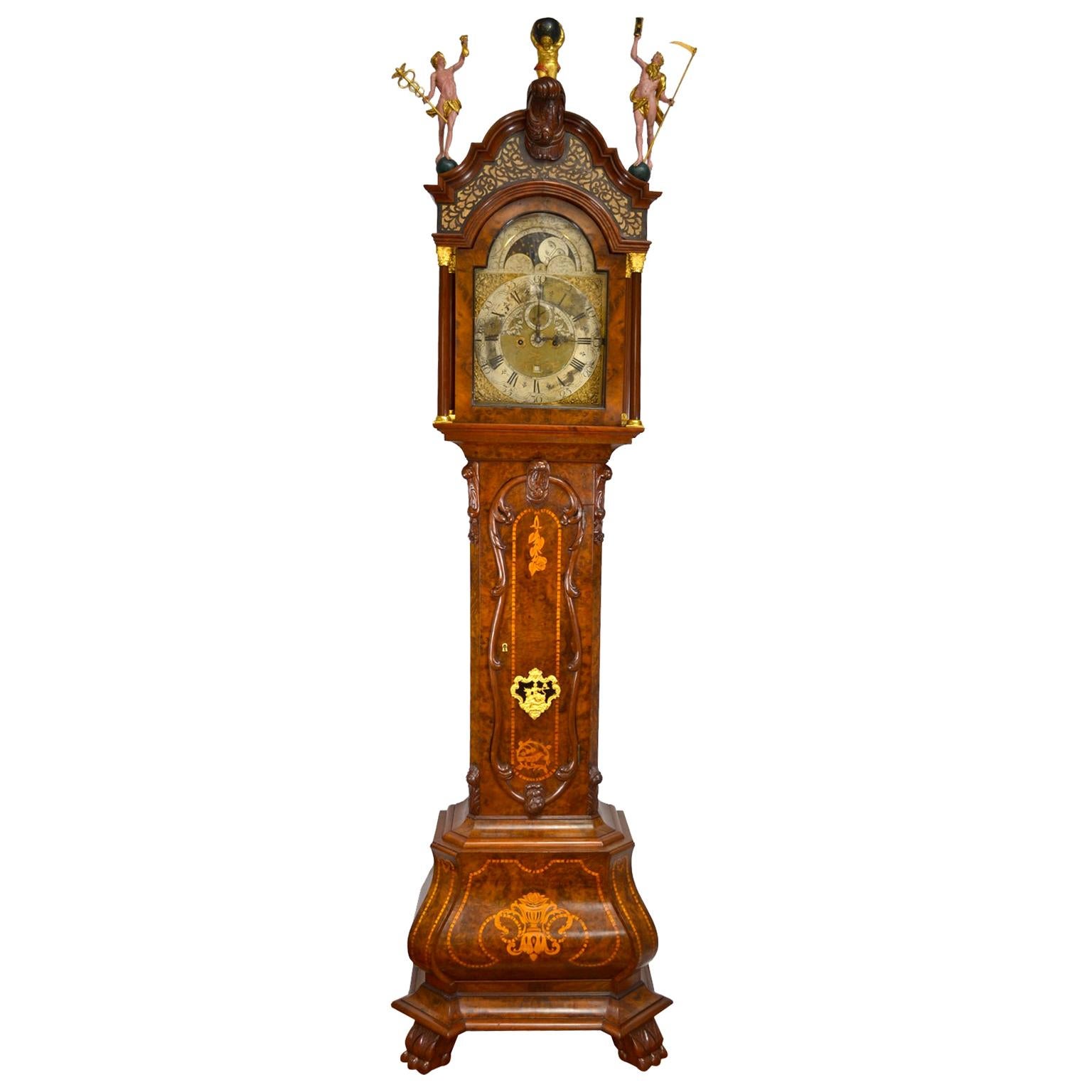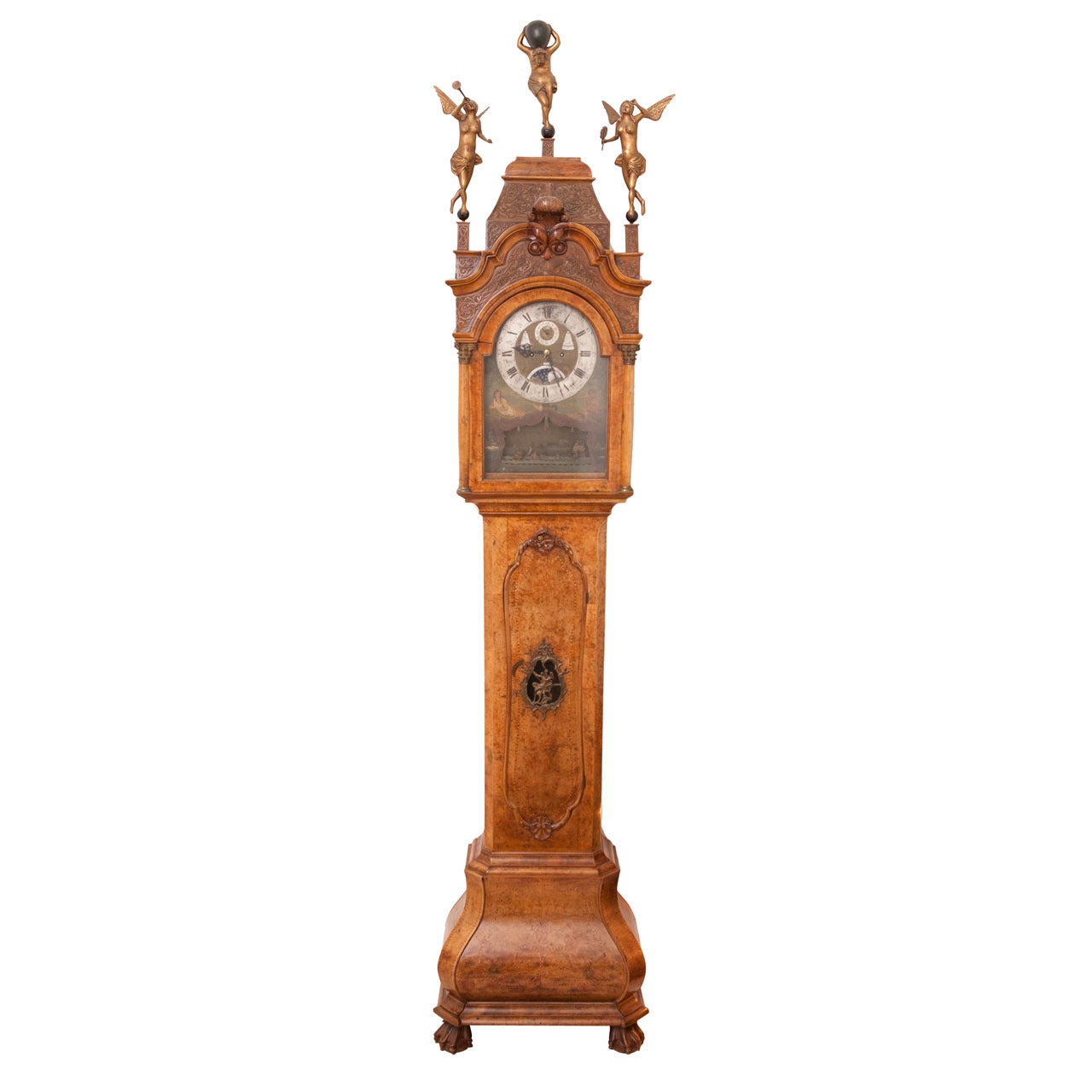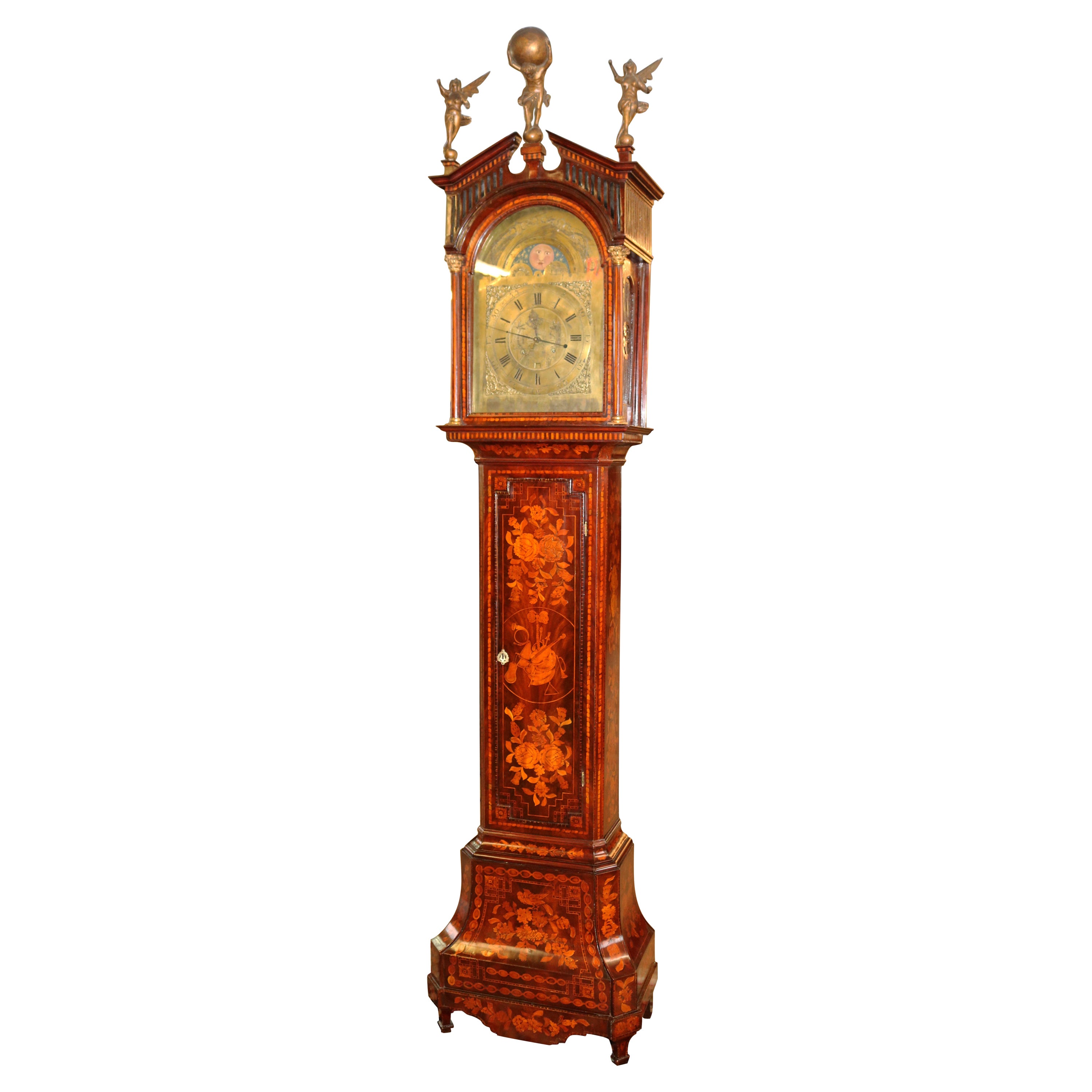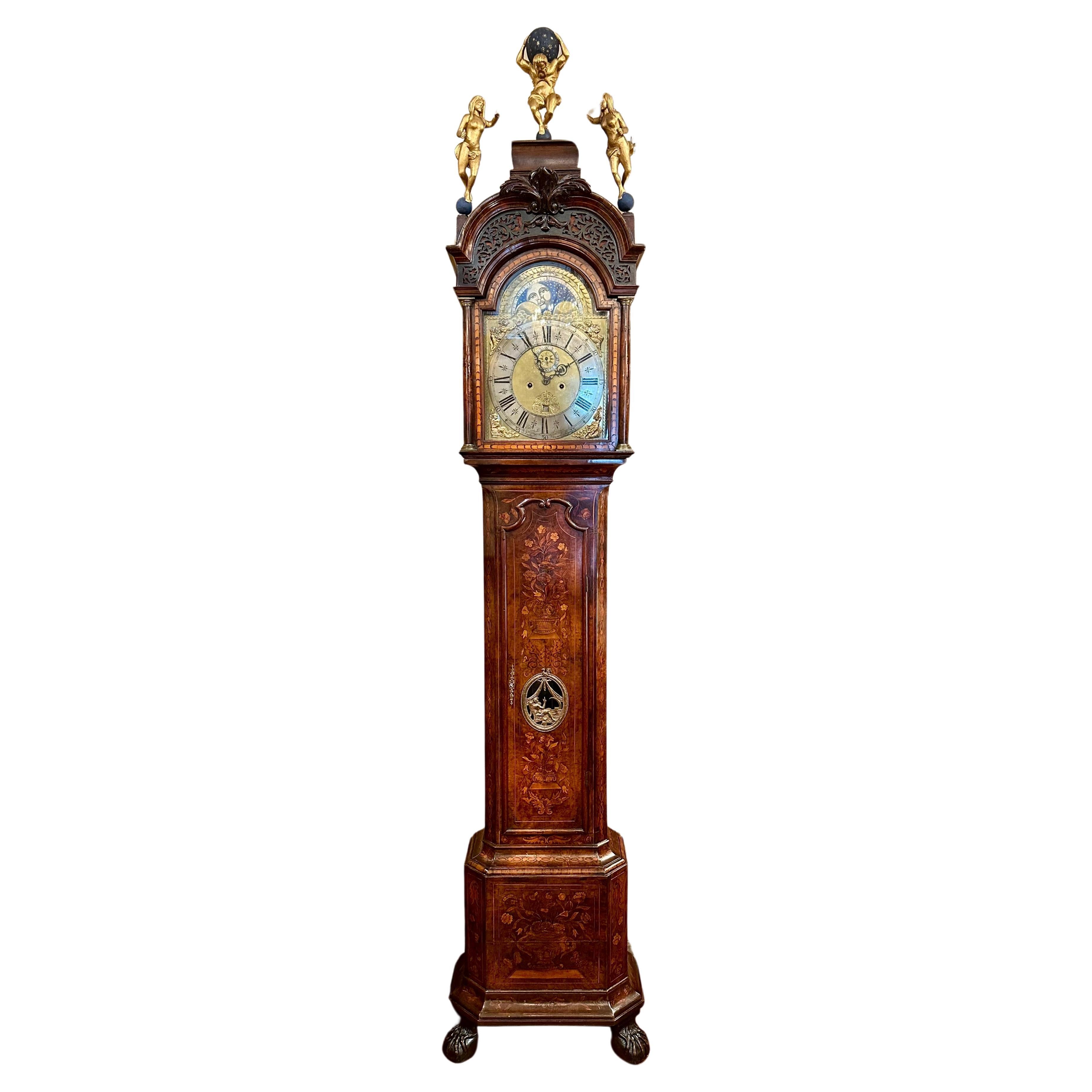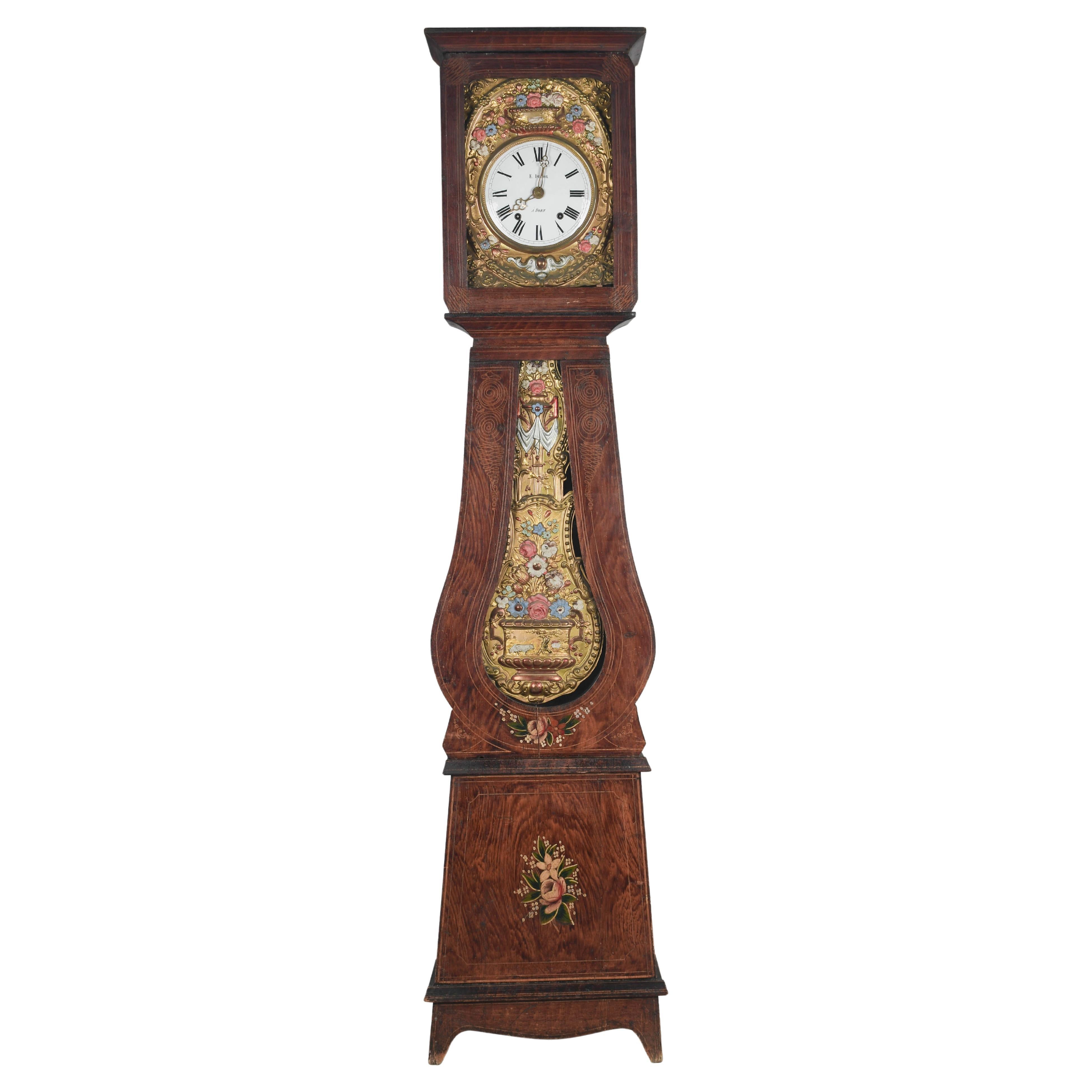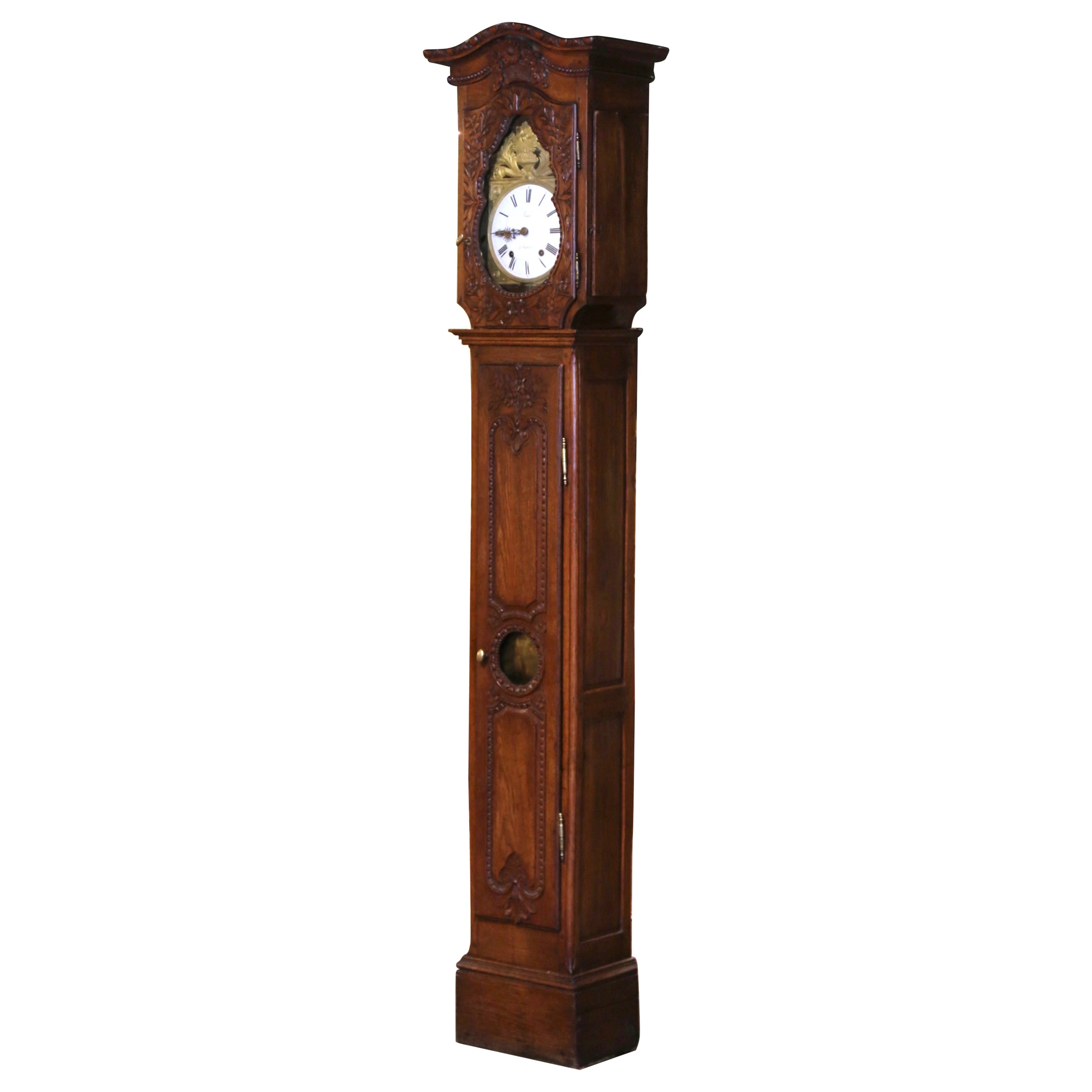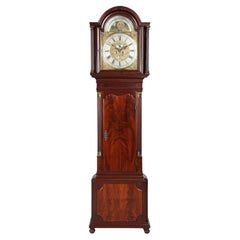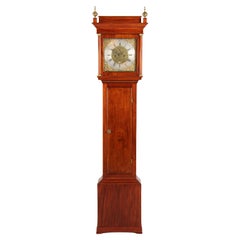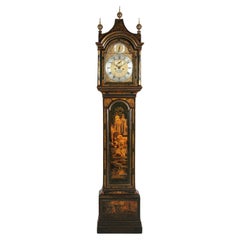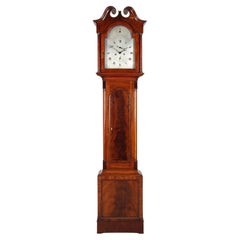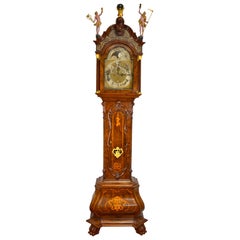Articoli simili a 18th Century Dutch Grandfather Clock, Calendar and Moonphases, Amsterdam 1760-70
Caricamento del video
Vuoi altre immagini o video?
Richiedi altre immagini o video al venditore
1 di 21
18th Century Dutch Grandfather Clock, Calendar and Moonphases, Amsterdam 1760-70
15.500 €IVA inclusa
Informazioni sull’articolo
Antique Amsterdam grandfather clock with alarm, calendar and moon phase
Amsterdam
Walnut root and others
circa 1760
Dimensions:
H x W x D: 283 x 58 x 30 cm - without figures the height is reduced to 241 cm
Description:
Elaborate grandfather clock in typical Amsterdam design with figure crowning.
The walnut-root veneered body with fine maple inlays stands on so-called ball-and-claw feet, which were particularly popular in the mid-18th century. The lower part of the body is, also typical of the time, strongly bulging, while the centre part is recessed in width and has a curved door at the top and bottom with thread inlays following this line. The asymmetrical, ormolu framing of the viewing window with its C-curves, flowers and rocailles corresponds to the formal language of the Rococo period.
The head of the clock is spectacular. The round arch supported by four columns with openwork above is complemented by a pedestal-like structure with carved and oil-gilt figures. On the left we see Hermes, the messenger of the gods, here as the patron saint of trade with a quill and purse; and on the right Fama, the goddess of fame with the Roman tuba in her hand. And enthroned above all this is Atlas, the Titan, holding the celestial globe.
A very similar case, with a clockwork by Otto van Meurs, is described in Jan Zeeman - De Nederlandse Staande Klok on pages 126-128. (See photo) It reads as follows:
Otto van Meurs had a particularly skilful case maker, distinguished by his refined workmanship and the beautiful colour of the walnut veneer. The inlay work on the double-curved base of the clock dates from this period. The moulded part on the pendulum window clearly shows that an elegant and playful interplay of lines was a basic requirement at this time.
It is obvious that the case of the clock on offer here comes from the workshop of this very case maker.
The dial is also particularly interesting. The moon phase and the age of the moon can be seen at the top of the arch. The fact that the moon is firmly mounted and the celestial disc rotates in front of it is unusual and therefore particularly noteworthy. This is a rare design which, in contrast to the usual rotating moon, still leaves space to the left and right of the arch. This space was used for a fine painting:
Against the expanse of the sky and in the shade of the trees, we see on the left hand side Spes, the personification of hope, leaning on an anchor and ensuring a good harvest; and on the right, Caritas as the personification of charity, here mercifully caring for the family.
Below this is a silver-plated chapter ring with black Roman numerals for the hours and Arabic numerals for the minutes, which are rotated from 20-40, typical of the time and region. The finely sawn and blued steel hands run in front of a small silver ring, which is used to set the alarm time.
Below this, we see the day of the week in a triangular window with the corresponding Greek symbol and a personification of a deity, in this case Chronos, who stands for Saturday and who limits life with his scythe. The other days of the week are symbolised by Diana, the goddess of the hunt on Monday; Ares, the god of war and battle on Tuesday; Hermes, the messenger of the gods on Wednesday; Zeus, the highest of all gods on Thursday; Venus, the goddess of love and beauty on Friday; and Apollo, the god of music and beautiful things on Sunday.
Above the winding holes we see a small sub-dial for the seconds, a window for the date and the signature of the master clockmaker - Jan Storm - Amsterdam.
The Storm family is recorded with several generations of clockmakers in Amsterdam from 1672. According to Enrico Morpurgo - Nederlandse klokken- en horlogemakers vanaf 1300, Jan Storm was active from 1717. The clock offered here probably dates from the last years of his workshop.
The weight-driven movement, with a power reserve of one week, strikes the number of hours on the half-hour and hour, and a single strike for each quarter hour.
Condition:
Very good, restored condition of movement and case. The movement has been completely dismantled, cleaned and overhauled, the case has been primed with shellac and matted with wax.
The top pedestal of the head was not present at the time of purchase and was added during the restoration according to the old model. On the photo showing the back wall of the case, you can see that the back wall was first shortened and then lengthened again, presumably for transport during a move.
We recommend the following literature for this clock:
Jan Zeeman - De Nederlandse Staande Klok
You can find out more about the creative period of the Storm clockmaking family in the following directory:
Enrico Morpurgo - Nederlandse klokken- en horlogemakers vanaf 1300
- Dimensioni:Altezza: 283 cm (111,42 in)Larghezza: 58 cm (22,84 in)Profondità: 30 cm (11,82 in)
- Stile:Luigi XV (Del periodo)
- Materiali e tecniche:
- Luogo di origine:
- Periodo:1760-1769
- Data di produzione:1760-1770
- Condizioni:Sostituzioni effettuate: The top pedestal of the head was not present at the time of purchase and was added during the restoration according to the old model. On the photo showing the back wall of the case, you can see that the back wall was first shortened and then lengthen. Usura compatibile con l’età e l’utilizzo. Very good, restored condition of movement and case. The movement has been completely dismantled, cleaned and overhauled, the case has been primed with shellac and matted with wax.
- Località del venditore:Greven, DE
- Numero di riferimento:1stDibs: LU5419245432442
Informazioni sul venditore
4,9
Venditore Platino
Venditori Premium con valutazione 4.7+ e tempi di risposta entro 24 ore
Fondazione nel 2014
Venditore 1stDibs dal 2020
196 vendite su 1stDibs
Tempo di risposta standard: <1 ora
- SpedizioneRecupero del preventivo…Spedizione da: Münster, Germania
- Politica di reso
Alcune parti di questa pagina sono state tradotte automaticamente. 1stDibs non può garantire che le traduzioni siano corrette. L’inglese è la lingua predefinita del sito.
Garanzia di autenticità
Nell’improbabile caso in cui si verifichi un problema con l’autenticità di un articolo, contattaci entro un anno per ottenere un rimborso completo. DettagliGaranzia di rimborso
Se il tuo articolo non corrisponde alla descrizione, è danneggiato durante il trasporto o non arriva, contattaci entro 7 giorni per un rimborso completo. DettagliAnnullamento entro 24 ore
Hai un periodo di tolleranza di 24 ore per annullare il tuo acquisto, senza necessità di fornire spiegazioni.Venditori professionali selezionati
I nostri venditori di livello internazionale devono aderire a rigorosi standard di servizio e qualità, garantendo l’integrità delle inserzioni.Garanzia miglior prezzo
Se scopri che un venditore ha pubblicato altrove lo stesso articolo a un prezzo più basso, applicheremo lo stesso prezzo.Consegna globale affidabile
La nostra rete di vettori leader del settore offre opzioni di spedizione specializzate in tutto il mondo, inclusa la consegna personalizzata.Altro da questo venditore
Mostra tuttoOrologio a cassa lunga inglese della fine del XVIII secolo con fasi lunari, Manchester, circa 1780
Orologio a pendolo inglese della fine del XVIII secolo con fasi lunari
Inghilterra (Manchester)
Mogano
seconda metà del XVIII secolo
Dimensioni: H. H. x L. x P. 209 x 56 x 25 cm
D...
Categoria
Di antiquariato/d’epoca, Fine XVIII secolo, Inglese, Orologi a pendolo e...
Materiali
Mogano
Orologio a pendolo inglese del XVIII secolo di James Pike
Antico orologio a pendolo di Giorgio III da Newton Abbot
Inghilterra (Newton Abbot)
Mogano
1790 circa
Dimensioni: H. H. x L. x P.: 207 x 50 x 27 cm.
Descrizione:
Un cofanetto in l...
Categoria
Di antiquariato/d’epoca, Fine XVIII secolo, Britannico, Orologi a pendol...
Materiali
Ottone
Orologio a pendolo Chinoiserie, Inghilterra, Londra, metà del XVIII secolo, orologio a cassa lunga
Di James Scholefield
Orologio a pendolo Chinoiserie
Inghilterra (Londra)
Oak verniciato
metà del XVIII secolo
Dimensioni: H. H. × L. × P. 236 × 48 × 24 cm
Descrizione:
Antico orologio inglese a cassa ...
Categoria
Di antiquariato/d’epoca, Metà XVIII secolo, Britannico, Cineserie, Orolo...
Materiali
Quercia
Orologio scozzese a cassa lunga realizzato da William Spark, Aberdeen, 1820 ca.
Orologio a pendolo di Giorgio III con quadrante argentato
Scozia (Aberdeen)
Mogano
Giorgio III intorno al 1820
Dimensioni: H. H. x L. x P.: 222 x 47 x 23 cm.
Descrizione:
Bellissi...
Categoria
Di antiquariato/d’epoca, Anni 1820, Scozzese, Giorgio III, Orologi a pen...
Materiali
Mogano
Orologio a pendolo inglese della metà del XIX secolo con quadrante rotondo dipinto
Antico orologio a pendolo inglese con quadrante dipinto e cassa in mogano
La cassa poggia su piccoli piedi rotondi e presenta un'ampia sezione inferiore, sopra la quale si trova una...
Categoria
Di antiquariato/d’epoca, Metà XIX secolo, Britannico, Orologi a pendolo ...
Materiali
Mogano
Orologio da tavolo del XIX secolo "Astronomia", Francia, 1830 circa
Antico orologio da camino sul tema dell'astronomia
Francia
Bronzo
Charles X intorno al 1830
Dimensioni: H. H. x L. x P.: 48 x 19 x 10 cm.
Descrizione:
Insolito orologio da camino ...
Categoria
Di antiquariato/d’epoca, XIX secolo, Francese, Carlo X, Orologi da tavol...
Materiali
Bronzo
Ti potrebbe interessare anche
Orologio olandese del XVIII secolo a cassa lunga o a padrone di casa 'Utrecht' di W.V. Dadelbeek
Di W.V. Dadelbeek
Orologio olandese a cassa lunga in noce, radica e intarsi di W.V. Dadelbeek, Utrecht. La cassa ha una forma tipica, porta a baule con fascia di piume, base a bombe, terminali origina...
Categoria
Di antiquariato/d’epoca, Metà XVIII secolo, Olandese, Luigi XV, Orologi ...
Materiali
Noce
Orologio di Amsterdam a cassa alta, firmato Pieter Verlaer, 1840-1860 circa
Orologio Amsterdam con cassa alta.
Firmato Pieter Verlaer,
Olandese, circa 1840-1860.
noce e noce sbavato.
L'orologio ha un incredibile quadrante con tre navi che si muovono in accor...
Categoria
Di antiquariato/d’epoca, XIX secolo, Olandese, Neorococò, Orologi
Materiali
Noce
Orologio a pendolo a cassa alta con intarsio olandese figurato della fine del XVIII secolo
Questo splendido orologio a cassa alta è stato realizzato nei Paesi Bassi alla fine del XVIII secolo. La cassa è magnificamente intarsiata e la parte superiore del cappuccio presenta...
Categoria
Di antiquariato/d’epoca, Fine XVIII secolo, Olandese, Coloniale olandese...
Materiali
Ottone
Antico orologio a pendolo olandese a intarsio "Pieter Paulus" di Amsterdam, CIRCA 1730.
Antico orologio a pendolo olandese con intarsio, quadrante e movimento di Pieter Paulus, Amsterdam, 1720-1740 circa.
Categoria
Di antiquariato/d’epoca, Inizio XVIII secolo, Olandese, Orologi a pendol...
Materiali
Legno di seta, Noce
Orologio a pendolo francese Comtoise del XIX secolo
Orologio a pendolo francese del XIX secolo, con cassa in pino dipinta in policromia e pendolo in ottone sbalzato. Movimento Morbier a sette giorni, pulito professionalmente e funzion...
Categoria
Di antiquariato/d’epoca, XIX secolo, Francese, Stile provenzale, Orologi...
Materiali
Ottone, Smalto
Orologio a cassa alta in Oak Oak intagliato del XVIII secolo proveniente dalla Normandia
Questo elegante orologio antico a cassa lunga è stato realizzato in Normandia, Francia, intorno al 1780. L'orologio a pendolo alto poggia su uno zoccolo inferiore dritto; presenta un...
Categoria
Di antiquariato/d’epoca, Metà XVIII secolo, Francese, Luigi XV, Orologi ...
Materiali
Quercia
